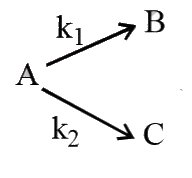For consecutive first order reaction
, at 300 K
and
The time which [B] will be maximum is
s
s
0 s
The correct Answer is:B
To determine the time at which the concentration of B is maximum in the consecutive first-order reaction Ak1→Bk2→C, we can use the formula for the time at which the concentration of an intermediate is maximum in consecutive reactions.
1. Identify the Rate Constants:
- Given:
- k1=2×10−3s−1
- k2=5×10−5s−1
2. Use the Formula for Maximum Concentration of B:
- The time at which the concentration of B is maximum (Tmax) can be calculated using the formula:
Tmax=2.303k2log10(k1k2)
3. Calculate k1k2:
- First, calculate the ratio:
k1k2=2×10−35×10−5=25×102=40
4. Calculate the Logarithm:
- Now, calculate the logarithm:
log10(40)≈1.602
5. Substitute Values into the Formula:
- Now substitute k2 and the logarithm into the formula:
Tmax=2.3035×10−5×1.602
6. Calculate Tmax:
- Calculate Tmax:
Tmax=2.303×1.6025×10−5≈3.6885×10−5≈73760seconds
7. Final Calculation:
- Simplifying gives:
Tmax≈73760seconds
Final Answer:
The time at which the concentration of B is maximum is approximately 73760 seconds.
- Given:
- k1=2×10−3s−1
- k2=5×10−5s−1
- The time at which the concentration of B is maximum (Tmax) can be calculated using the formula:
Tmax=2.303k2log10(k1k2)
- First, calculate the ratio:
k1k2=2×10−35×10−5=25×102=40
- Now, calculate the logarithm:
log10(40)≈1.602
- Now substitute k2 and the logarithm into the formula:
Tmax=2.3035×10−5×1.602
- Calculate Tmax:
Tmax=2.303×1.6025×10−5≈3.6885×10−5≈73760seconds
- Simplifying gives:
Tmax≈73760seconds
The time at which the concentration of B is maximum is approximately 73760 seconds.
Topper's Solved these Questions
- BOOK - ERRORLESSCHAPTER - CHEMICAL KINETICSEXERCISE - NCERT BASED QUESTIONS (Collision Theory, Energy of Activation and Arrhenius Equation)54videos
CHEMICAL KINETICS
- BOOK - ERRORLESSCHAPTER - CHEMICAL KINETICSEXERCISE - NCERT BASED QUESTIONS (Photochemical Reaction)4videos
CHEMICAL KINETICS
- BOOK - ERRORLESSCHAPTER - CHEMICAL KINETICSEXERCISE - Assertion & Reason6videos
CHEMICAL KINETICS
- BOOK - ERRORLESSCHAPTER - CARBOXYLIC ACIDSEXERCISE - Assertion & Reason5videos
CARBOXYLIC ACIDS
- BOOK - ERRORLESSCHAPTER - CHEMISTRY IN EVERYDAY LIFE EXERCISE - Assertion & Reason4videos
CHEMISTRY IN EVERYDAY LIFE
Similar Questions
For the reaction

k1=1.78×10−3s−1 and k2=5.8×10−5s−1 for the initial concentration of [Cr(H2O)4Cl2]⊕ is 0.0174molL− at 0∘C. Calculate the value of time at which the concentration of [Cr(H2O)5Cl]2+ is maximum.View SolutionA substance undergoes first order decomposition. The decomposition follows two parallel first order reactions as :
k1=1.26×10−4s−1,k2=3.8×10−5s−1
The percentage distribution of B and C are :
 View Solution
View Solution
Knowledge Check
- Question 1 - Select One
For 2Ak1−−→Bk2−−→3C.K1=2×10−4sec−1andk2=3×10−4/mol-sec. {d[B]/dt} equal to :
Ak1[A]−k2[B]Bk1[A]2−k2[B]Ck1[A]−k2[B]2Dk1[A]2−k2[C]3 - Question 2 - Select One
For the sequential first order reactions:
(,Ak1=2×10−4s−1−−−−−−−−−−→,Bk2=10s−1−−−−−−→,C),(t=0,0.4M ,0,0):}
the time after which the concentration of C cecomes 0.3 M is:AIn2k1BIn4k1CIn2k2DIn4k2 - Question 3 - Select One
For the consecutive unimolecular-type first-order reaction Ak1−−→Rk2−−→S, the concentration of component R, CR at any time t is given by -
CR=COAK1[e−k1t(k2−k1)+e−k2t(k1−k2)]
if CA=CAO,CR=CRO=0 at t=0
The time at which the maximum concentration of R occurs is -Atmax=k2−k1ln(k2/k1)Btmax=ln(k2/k1)k2−k1Ctmax=ek2/k1k2−k1Dtmax=ek2−k1k2−k1
The substance undergoes first order decomposition. The decomposition follows two parallel first order reactions as :

K1=1.26×10−4sec−1andK2=3.8×10−5sec−1 The percentage distribution of B and CView SolutionA substance undergoes first order decomposition. The decomposition follows two parallel first order reactions as
 , k1=1.26×10−4 sec−1andk2=3.6×10−5 sec−1 Calculate the % distribution of B & C.View Solution
, k1=1.26×10−4 sec−1andk2=3.6×10−5 sec−1 Calculate the % distribution of B & C.View SolutionFor the following sequential reaction,
AK1−−→BK2−−→C
Find out the concentraion of C at tiem t=1 day. Given that K1=1.8×10−5s−1 and K2=1.1×10−2s−1 and initial molar concentration of A is 1.8View SolutionWrite a stoichiometric equation for the reaction between A2 and C whose mechanism is given below. Determine the value of equilibrium constant for the first step. Write a rate law equation for the over all reaction in terms of its initial reactants.
(i) A2K1⇐⇒K22A
K1=1010s−1 and K2=1010M−1s−1
(ii) A+C→AC
K=10−4M−1S−1View SolutionpKa of a base (Kb=1×10−5 is
View Solution

